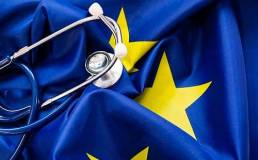Introduction
The digitalisation of national health systems, their Europe-wide interconnection, and the associated EU-wide use of health data, holds immense potential. It will create enormous value and innovation gains for European society and in particular for national health systems. For example, digital technologies can substantially increase the efficiency of service provision — as well as administration, treatment and care — by renewing and optimising processes, so that the scarce (especially financial) resources of the healthcare system can be used more effectively. But not only that – it will also be of direct benefit to patients because the use of health data can help to significantly increase diagnostics, the development of innovative therapies and the overall quality of healthcare. Until now, health data has generally been stored in a fragmented fashion around the EU, mainly by different doctors, hospitals, and other healthcare providers. Access is extremely difficult in many Member States.
Access to health data has been hugely difficult in many member states
The proposed Regulation for a European Health Data Space (EHDS; hereinafter also referred to as the „Commission Proposal“) therefore comprehensively regulates two forms of data use: firstly, the use of health data in the context of individual healthcare (e.g. when visiting a doctor) – i.e. so-called primary use of health data. And, secondly, so-called secondary use of health data, which means processing for other purposes — i.e. anything other than individual healthcare — with „social benefits“, such as research, policy making, personalised medicine, official statistics or regulatory activity [Art. 2 (2) (e) Commission Proposal]. Two separate data infrastructures are being set up for this purpose: (1) „MyHealth@EU“ and (2) „HealthData@EU“.

To „opt-out“ or not to „opt-out“ – that is the question
The Commission Proposal is far from perfect — in the now forthcoming legislative process, a whole series of detailed and contentious issues will have to be clarified. The most critical point is probably that of individual control over one’s own health data.
The Commission Proposal provides for various safeguards in the context of individual healthcare (e.g. when visiting a doctor). For example, the individual can deny third parties, e.g. doctors, access to health data in whole or in part [Art. 3 (9) Commission Proposal]. In this area — i.e. so-called primary use of health data — quite effective control is in place overall for each individual.
Data from electronic health records could be used for research, policy-making and regulatory activity without requiring the consent of the individual.
The situation is different in the area of so-called secondary use of health data. In principle, data from electronic health records, for example, can be used for research, policy-making and regulatory activity without requiring the consent of the individual. The Commission Proposal does provide for a comprehensive evaluation procedure for data permits, and the threat of sanctions. For example, health data may only be used for legally defined purposes [Art. 34 (1) Commission Proposal]. In particular, any attempt to use health data for actions to the detriment of the data subject, to increase insurance premiums, promote products or treatments or to develop harmful products is prohibited [Recital 41 and Art. 35 Commission Proposal].
Health data is highly sensitive and worthy of protection, that is why it is crucial to take a different approach to that of the USA or China
However, there is a conflict between individual data sovereignty and the EU-wide efficient use of health data. On the one hand, there is a need for an effective framework for regulating data use, which supports the secondary use of health data — i.e. research and development, policy-making and regulatory activity — and which fosters innovation. Such a framework is crucial if Europe is to avoid getting left behind in the global political race. On the other hand, when it comes to data policy, Europe will — and must — take a different approach to that of the USA and China. Health data is after all highly sensitive and worthy of protection. Here too, therefore, EU citizens should have the „last word“ — fully respecting genuine freedom of choice for the individual. In this respect, we argue that individual freedom of choice must be the defining feature of this European approach — including with regard to the secondary use of health data.
It is possible to safeguard the individual’s freedom whilst at the same taking health data to a good use
The question is how this conflict can be sensibly resolved. The safeguards provided for in the Commission Proposal (e.g. data permit procedures and sanctions) are appropriate and necessary. However, when deciding on the release of electronic health records data for purposes other than an individual’s own healthcare, the Commission Proposal should be extended to include an „opt-out“. Finland has shown that a „right to opt-out“ can work without, for example, obstructing research and development: The „opt-out“ principle there applies to the release of health data for research purposes, and individuals can easily exercise this right via an online form. Finland has acquired a large stock of data while preserving the individual’s freedom of choice. In this respect, a European right to „opt-out“ would reconcile the different objectives without affecting the meaning and purpose of the EHDS.
Conclusion
Digitalising national health systems and linking them up across Europe is an immense undertaking but the potential value and innovation gains from using health data throughout the EU are enormous. Until now, health data has generally been stored in a fragmented fashion and access is extremely difficult in many Member States. The EHDS offers a real opportunity for substantial progress.
The Commission Proposal already provides for meaningful safeguards (data permit procedures and sanctions) with regard to the secondary use of health data, i.e. for research, policy making, personalised medicine, official statistics or regulatory activity. However, there is an additional need to introduce a „right to opt out“ that would reconcile the different objectives of the EHDS. Such an „opt-out“ has been shown to work in the EU without obstructing research and development. Thus, the individual’s freedom of choice can be preserved while still acquiring a large stock of data, which can then be used to relieve the burden on health systems, encourage innovation and create real added value for patients. This is, indeed, a project of the century.
This contribution is an abridged and revised version of the cepPolicyBrief 13/2022 and based on a contribution to agendadigitale.eu.

More about Health in EU:
Copyright Header Picture: shutterstock/GeckoStudio; picture of European flag: shutterstock/Yavdat; picture of Finland on a map: shutterstock/hyotographics; picture of Author: copyright Patrick Stockebrandt.
Könnte Sie auch interessieren
9. Juli 2024
Konstantin von Notz : „Es ist Zeit, unsere Demokratien sehr entschlossen aufzustellen“
Er steht seit diesem Jahr an der Spitze des Geheimdienstausschusses des…
1. Juli 2024
European Parliamentary Elections: A Debacle for Pro-EU Parties or Their Last Chance?
Between 6 and 9 June, 400 million Europeans voted in the European Parliamentary…
24. Juni 2024
Dissolution of Parliament: Good or Bad for Democracy?
An hour after the results of the European elections, Emmanuel Macron announced…



